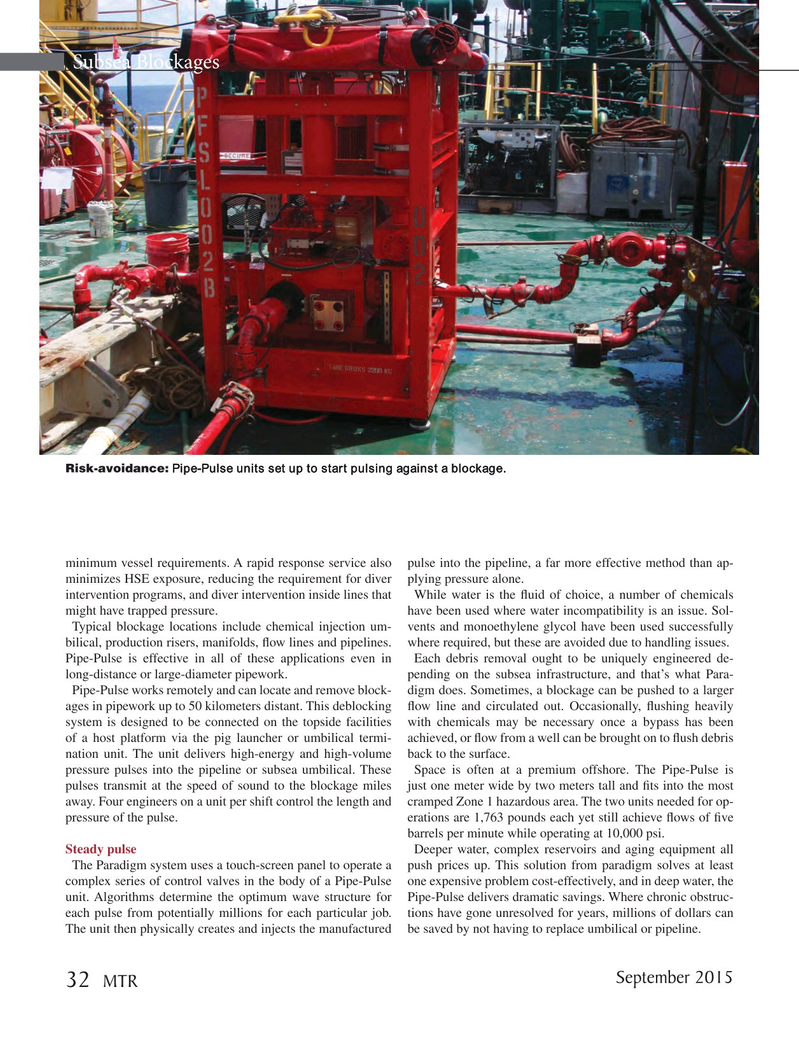
Page 32: of Marine Technology Magazine (September 2015)
Ocean Observation: Gliders, Buoys & Sub-Surface Networks
Read this page in Pdf, Flash or Html5 edition of September 2015 Marine Technology Magazine
Subsea Blockages
Risk-avoidance: Pipe-Pulse units set up to start pulsing against a blockage.
minimum vessel requirements. A rapid response service also pulse into the pipeline, a far more effective method than ap- minimizes HSE exposure, reducing the requirement for diver plying pressure alone.
intervention programs, and diver intervention inside lines that While water is the ? uid of choice, a number of chemicals might have trapped pressure. have been used where water incompatibility is an issue. Sol-
Typical blockage locations include chemical injection um- vents and monoethylene glycol have been used successfully bilical, production risers, manifolds, ? ow lines and pipelines. where required, but these are avoided due to handling issues.
Pipe-Pulse is effective in all of these applications even in Each debris removal ought to be uniquely engineered de- long-distance or large-diameter pipework. pending on the subsea infrastructure, and that’s what Para-
Pipe-Pulse works remotely and can locate and remove block- digm does. Sometimes, a blockage can be pushed to a larger ages in pipework up to 50 kilometers distant. This deblocking ? ow line and circulated out. Occasionally, ? ushing heavily system is designed to be connected on the topside facilities with chemicals may be necessary once a bypass has been of a host platform via the pig launcher or umbilical termi- achieved, or ? ow from a well can be brought on to ? ush debris nation unit. The unit delivers high-energy and high-volume back to the surface.
pressure pulses into the pipeline or subsea umbilical. These Space is often at a premium offshore. The Pipe-Pulse is pulses transmit at the speed of sound to the blockage miles just one meter wide by two meters tall and ? ts into the most away. Four engineers on a unit per shift control the length and cramped Zone 1 hazardous area. The two units needed for op- pressure of the pulse. erations are 1,763 pounds each yet still achieve ? ows of ? ve barrels per minute while operating at 10,000 psi.
Steady pulse Deeper water, complex reservoirs and aging equipment all
The Paradigm system uses a touch-screen panel to operate a push prices up. This solution from paradigm solves at least complex series of control valves in the body of a Pipe-Pulse one expensive problem cost-effectively, and in deep water, the unit. Algorithms determine the optimum wave structure for Pipe-Pulse delivers dramatic savings. Where chronic obstruc- each pulse from potentially millions for each particular job. tions have gone unresolved for years, millions of dollars can
The unit then physically creates and injects the manufactured be saved by not having to replace umbilical or pipeline.
September 2015 32 MTR
MTR #7 (18-33).indd 32 MTR #7 (18-33).indd 32 9/1/2015 10:35:14 AM9/1/2015 10:35:14 AM

 31
31

 33
33
